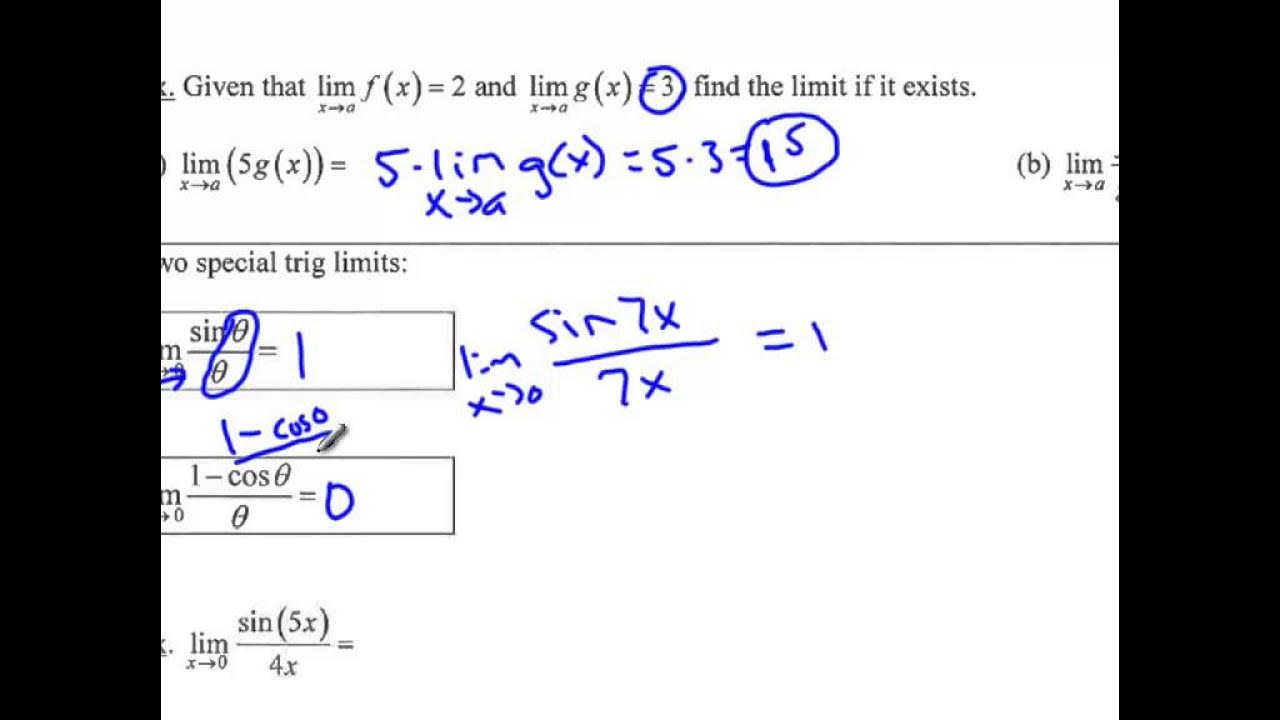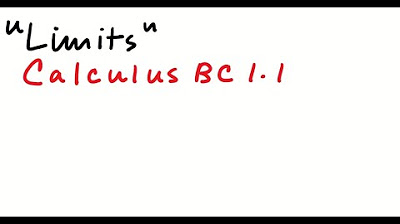AP Calculus AB: Understanding how to evaluate limits algebraically and analyze limits graphically
TLDRThis video script offers an in-depth tutorial on calculus, focusing on understanding and evaluating limits. It covers the process of plugging in values, handling indeterminate forms through factoring, and graphical analysis of limits from both left and right sides. The instructor emphasizes the importance of recognizing when limits do not exist, such as at points of discontinuity, unbounded behavior, or oscillation. Additionally, the script introduces properties of limits, including scalar multiplication, and sum, difference, product, and quotient rules. The tutorial also touches on transcendental functions and concludes with a preview of derivative concepts, providing a comprehensive foundation for students new to calculus.
Takeaways
- 📘 The first step in evaluating limits is to plug in the value and see if it results in an indeterminate form like 0/0.
- 🔍 When a limit results in an indeterminate form, techniques like factoring can be used to simplify the expression and find the limit.
- 📊 To determine if a limit exists, it's important to check both the left and right-hand limits and ensure they are approaching the same value.
- 🚫 A limit does not exist if the function is unbounded (approaching infinity or negative infinity) or if it oscillates at a certain point.
- 🔢 For limits involving transcendental functions, simply plug in the value of x and use the properties of the functions (e.g., sine, cosine, e).
- 📉 When dealing with complex fractions or composite functions, it's often easier to simplify the expression before evaluating the limit.
- ✂️ Factoring can be particularly useful for simplifying cubic expressions and for rationalizing expressions involving radicals.
- 🔄 The properties of limits, such as the scalar property and the sum/difference/product/quotient rules, allow for the breaking down of complex limits into simpler parts.
- 📌 Remember that the limit represents an approach to a value, not the value at the point itself, especially when the function is undefined at that point.
- 📐 Graphical understanding of limits is crucial, as it helps visualize the behavior of the function as it approaches a certain value.
- 📝 When preparing for derivatives, understanding how to evaluate limits of expressions involving delta x is fundamental, as shown in the example with the expanded form.
Q & A
What is the first step in evaluating a limit?
-The first step in evaluating a limit is to plug in the value of the variable that the limit is approaching.
What does it mean when you encounter an 'indeterminate form' like 0/0 when evaluating a limit?
-An indeterminate form like 0/0 means that the limit cannot be directly evaluated by simply plugging in the value. You need to modify the expression, often by factoring or using other algebraic techniques, to simplify the expression before evaluating the limit.
Why is it important to check both the left and right sides when evaluating a limit graphically?
-Checking both the left and right sides is important because for a limit to exist, the function must approach the same value from both sides. If the left and right limits are not equal, the limit does not exist.
What is the difference between a limit existing and a function being defined at a certain point?
-A limit exists if the function approaches a specific value as the variable approaches a certain point, even if the function is not defined at that point. For example, the limit may exist as x approaches 3, but if the function is not defined at x=3 (e.g., there's a hole or a vertical asymptote), then f(3) does not exist.
What does it mean for a limit to not exist due to the function oscillating?
-A limit does not exist if the function oscillates between different values at the point the limit is being approached. This means the function does not approach a single, consistent value as the variable gets closer to that point.
How can you handle a limit problem where you have a complex fraction?
-To handle a limit problem with a complex fraction, you can try to simplify the expression by finding a common denominator or by multiplying the numerator and denominator by a suitable expression to eliminate the fraction within the fraction.
What is the scalar property of limits, and how can it be used?
-The scalar property of limits states that if you have a constant multiplying a function, you can take the constant outside of the limit expression, evaluate the limit of the function, and then multiply the constant by the result.
What is the rule for evaluating the limit of a sum or difference of functions?
-The rule for evaluating the limit of a sum or difference of functions is that you can break apart the limit into the sum or difference of the individual limits of each function.
How do you evaluate the limit of a product of functions?
-To evaluate the limit of a product of functions, you can take the limit of each function individually and then multiply the results together.
What is the process for evaluating the limit of a quotient of functions?
-To evaluate the limit of a quotient of functions, you take the limit of the numerator and divide it by the limit of the denominator, assuming both limits exist and the denominator's limit is not zero.
How can you simplify a limit expression that results in an indeterminate form like 0/0 after plugging in the value?
-You can simplify an indeterminate form like 0/0 by factoring the numerator and/or denominator to cancel out terms, or by using other algebraic manipulations such as expanding or rationalizing the expression.
Outlines
📚 Understanding Limits in Calculus
This paragraph introduces the concept of limits in calculus, emphasizing the importance of evaluating limits by plugging in values and the common indeterminate form of 0/0. The instructor uses an example to demonstrate how factoring can resolve such indeterminate forms, leading to a determinable limit. Additionally, the paragraph highlights the necessity of checking limits from both the left and right sides and clarifies that limits only approach a value but never actually reach it, as illustrated with several graphical examples. The instructor also points out situations where limits do not exist, such as when the function is unbounded or undefined at a specific point.
🔍 Deep Dive into Limit Evaluation Techniques
The second paragraph delves deeper into the process of evaluating limits, discussing the properties of limits and how they can be manipulated mathematically. It covers the scalar property, which allows constants to be factored out, and the sum, difference, and product rules, which permit the separation of limits for individual functions. The paragraph also addresses the limit of a quotient, explaining that it is the quotient of the individual limits. The instructor provides examples to illustrate these concepts, including factoring cubic expressions and rationalizing expressions with radicals, and emphasizes the initial step of simply plugging in values to evaluate limits.
📉 Analyzing Transcendental Functions and Limits
This paragraph focuses on the limits of transcendental functions, providing examples of how to evaluate them by plugging in values. The instructor demonstrates this with functions involving sine, natural logarithms, cosine, tangent, and exponential functions. Each example is straightforward, showing that in many cases, the limit can be found by direct substitution. The paragraph also touches on the handling of complex fractions and composite functions, where the limits are evaluated by first addressing the innermost function and then proceeding outward.
🔑 Unlocking Composite Functions and Advanced Limit Concepts
The final paragraph discusses composite functions and the approach to evaluating their limits. The instructor shows how to handle expressions where the limit results in an indeterminate form by expanding and simplifying the expression. This includes multiplying out terms and factoring to eliminate fractions, leading to a determinable limit. The paragraph also introduces the concept of using the power rule with logarithms and concludes with a preview of derivative-related concepts, suggesting that the methods taught will be valuable in understanding derivatives in the future.
Mindmap
Keywords
💡Calculus
💡Limits
💡Indeterminate Form
💡Factoring
💡Graphical Evaluation
💡Scalar Multiplication
💡Sum and Difference of Limits
💡Product of Limits
💡Quotient of Limits
💡Transcendental Functions
💡Composite Functions
💡Rationalizing
💡Power Rule with Logarithms
Highlights
Introduction to evaluating limits by plugging in values and addressing indeterminate forms like 0/0 through factoring.
Graphical interpretation of limits, emphasizing checking from both left and right sides for limit existence.
Explanation of the concept that limits only approach a value but never actually reach it.
Demonstration of how to handle limits at points where the function is undefined or missing.
Illustration of limits that do not exist due to unbounded behavior or oscillation.
Application of the scalar property of limits, allowing constants to be factored out and multiplied back in.
Use of sum and difference rules for limits, enabling separate evaluation of limit components.
Product rule for limits, allowing for the individual evaluation of multiplied functions within a limit.
Quotient rule for limits, involving the division of individual limits' results.
Advice on the initial approach to evaluating limits by plugging in values before attempting factoring.
Technique for simplifying complex limits by breaking them down into more manageable parts.
Process of rationalizing expressions to remove radicals when evaluating limits.
Handling of transcendental functions in limits, such as sine, cosine, and natural logarithms.
Approach to evaluating limits involving exponential functions and their properties.
Solving complex fractions by rearranging and simplifying to avoid indeterminate forms.
Composite functions limits evaluation by plugging in the inner function before taking the limit.
Introduction to derivatives preparation with an example of expanding and simplifying an expression involving delta x.
Transcripts
Browse More Related Video

One-sided limits from tables | Limits and continuity | AP Calculus AB | Khan Academy

Limits and Their Properties

Definition of a Limit

Limits! Part 2

Limits of combined functions: piecewise functions | AP Calculus AB | Khan Academy

Worked example: Continuity at a point | Limits and continuity | AP Calculus AB | Khan Academy
5.0 / 5 (0 votes)
Thanks for rating: